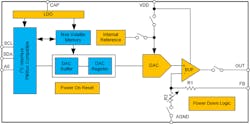Download this article in PDF format.
Smaller designs are certainly popular—it’s been the trend for years. Virtually all electronic devices and equipment have been continuously downsized for decades. People seem to like “small.” But is small good? The answer is, of course, it depends. Some items are better when they’re miniaturized, others are not.
But here’s the point. Chip manufacturers are still on the path of creating smaller and smaller ICs. Component geometries on the wafer continue to shrink, which makes for even smaller packages. These newer, tinier devices will ultimately let you design some substantially miniaturized products if that’s the goal. Texas Instruments is on that reduction path—here’s a look at some of what’s possible with the company’s products.
Sponsored Resources:
- Designing a compact signal chain for high performance in small spaces
- How tiny data converters give you more value
- Learn how to design smaller with tiny sensors
The Pros and Cons of Miniaturization
Even if the key specifications of any new design portend “make it smaller,” you should do an analysis of that with regard to the market, application, function, customer, and any related factors. Let’s look at the good and the bad news.
First, what true benefits accrue from going small? For products that must occupy a limited space, small is obviously good. Less weight also tends to go along with small. For example, space craft would benefit. And some automotive designs are desirable because of the inherent limited space in a vehicle and the usual negative effect of too much extra weight.
Smaller PCBs are definitely less expensive, especially those of the multilayer type. Further, by consolidating the functionality of the IC design by putting more on the same chip, both cost savings as well as a performance boost are possible. Small is also a cue for engineering bragging rights in design acumen, e.g., “look at how tiny I can make this thing.”
As for the downside, you need to look at several factors. Foremost is the difficulty of the design itself. Smaller printed circuit boards (PCBs) make layout tighter and more difficult. Close packing of components increases heating and cooling issues. Will overall efficiency be impacted? Smaller sizes usually require special packaging process that could lead to higher costs.
In addition, will testing of the small product be more difficult and expensive? And what about repair and replacement? The smaller the item, the more difficult to it is to troubleshoot and repair. Given that ICs are more rugged and reliable than ever before, reliability will not be compromised and most of the issues outlined above are clearly mitigated. With new components that address the downsizing movement, it’s an excellent option. It’s okay to push down the path for smaller designs. What follows are some examples that illustrate what’s possible for you today.
Small Design Use Cases
Data converters show up in most new designs today. These circuits represent how smaller versions can provide good value while meeting all of your design goals. Both analog-to-digital and digital-to-analog converters (ADCs and DACs) have been downsized considerably over the past years. But these devices almost always needed a batch of space-hogging discrete components for biasing, interfacing, or compensation. Not anymore. At TI, many if not most of these external parts and circuits have been fully folded into the chip.
The TI DAC53401 DAC integrates the internal reference source and an output amplifier with access to the op-amp circuitry so that you can select gain or make adjustments (see figure). An internal EEPROM and slew rate control lets you make a precision bias voltage source. The whole thing is housed in a 2- × 2-mm package. Yes, 2 mm.
A variety of new parts come with integrated digital features. For instance, the 12-bit AD7138 ADC is available with a digital comparator and circuitry for averaging up to 128 samples to reduce noise. Even a CRC is an integrated option. Some of these features also help diminish the workload of any companion MCU embedded controller. The packaging sizes are minuscule, such as 1.5 × 1.5 mm, 2 × 2 mm, or 3 × 3 mm.
Your industrial isolated CAN designs can be downsized considerably without compromising performance by incorporating the new smaller device. High-speed optocouplers are commonly used to ensure that ground potential differences between widely spaced industrial products won’t develop. But these optocouplers take up an amazing amount of space, forcing some equipment to grow in size. With the TI ISO 1042/44 CAN transceivers, the large optocouplers can be completely eliminated thanks to the fully integrated capacitive isolation features.
While ICs continue to shrink, the same is true for sensors. Sensors are at the heart of most industrial applications, so miniaturized versions are much welcomed in designing advanced industrial equipment. TI’s HDC2010 humidity and temperature sensor and its TMP61 linear thermistor sensor, offered in wafer-level chip-scale packages (WLCSPs), match up well with other miniature parts that make up industrial products. Good choices for companion design components are the TLV9061 op amp in a 0.08- × 0.08-mm package and an ISO1500 isolated RS-485 transceiver.
The bottom line is simply this: Smaller IC packages will save space and weight and be totally cost-effective without sacrificing performance or compromising PCB layout simplicity.
Sponsored Resources:

